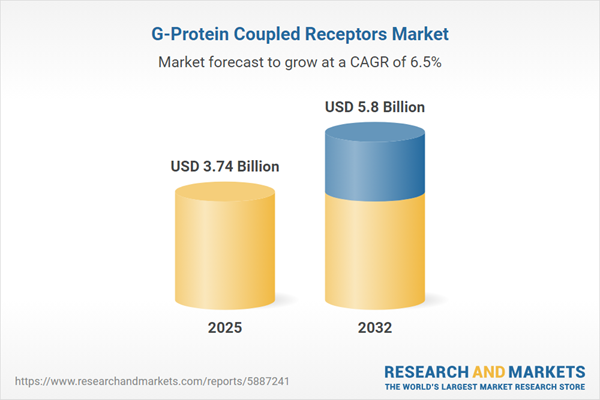Speak directly to the analyst to clarify any post sales queries you may have.
The G Protein Coupled Receptors (GPCR) market is evolving rapidly, supported by a blend of new technologies and collaborative initiatives that drive innovation across the biopharmaceutical sector. Senior decision-makers need reliable market intelligence to address regulatory shifts and competitive advancements in this critical area.
Market Snapshot: GPCR Market Size & Growth Outlook
The global GPCR market shows consistent growth, propelled by ongoing advancements in drug discovery and clinical diagnostics. The market is set to increase from USD 3.51 billion in 2024 to USD 3.74 billion in 2025, with projections suggesting a reach of USD 5.80 billion by 2032. This reflects a compound annual growth rate (CAGR) of 6.46%. Established pharmaceutical companies and biotechnology firms are intensifying collaborative strategies to expand their commercial footprint. Technology transfer and streamlined commercialization highlight GPCRs’ strategic role as essential mechanisms within emerging biopharma business models.
Scope & Segmentation: Comprehensive GPCR Market Analysis
- Receptor Classes: Class A Rhodopsin receptors (including chemokine and monoamine pathways), Class B Secretin, Class C Metabotropic Glutamate, Class F Frizzled/Taste 2, and Orphan Receptors drive targeted therapies, facilitating innovation across a broad spectrum of clinical indications.
- Therapeutic Areas: Cardiovascular diseases, central nervous system disorders, gastrointestinal disorders, oncology, metabolic syndromes, respiratory diseases, pain management, and inflammatory conditions represent the most prominent clinical applications, reflecting GPCRs’ adaptability and potential.
- Application Types: Spanning basic research, clinical diagnostics, and advanced drug development, the sector empowers R&D productivity and transitions innovative discoveries toward market-ready therapies.
- End User Segments: Academic institutions, contract research organizations, diagnostic laboratories, pharmaceutical manufacturers, and biotechnology firms play pivotal roles in accelerating GPCR research, treatment options, and technology transfer.
- Geographical Regions: Key markets include the Americas—with significant focus on the US and Canada—Europe, the Middle East & Africa, and Asia-Pacific. Countries such as China, India, and Japan are increasingly influential, driven by regulatory initiatives and expanded manufacturing capacity.
- Key Company Profiles: F. Hoffmann-La Roche Ltd., Novartis AG, Pfizer Inc., Merck & Co., Inc., Johnson & Johnson, AstraZeneca PLC, Sanofi S.A., Bristol-Myers Squibb Company, GlaxoSmithKline plc, and AbbVie Inc. are shaping the landscape through research partnerships and commercialization of GPCR technologies.
Key Takeaways for Senior Decision-Makers
- Emerging technologies—including cryo-electron microscopy and machine learning—are improving drug target validation and accelerating the development life cycle for novel GPCR-based treatments.
- Strategic collaborations among pharmaceutical, biotechnology, and academic stakeholders are boosting research productivity and operational responsiveness within the biopharma value chain.
- Procurement strategies are shifting toward regionalized and diverse sourcing, enhancing continuity and resilience in response to evolving regulatory scenarios.
- Next-generation GPCR platforms such as biased agonists and allosteric modulators are diversifying R&D pipelines, expanding the potential for clinical applications across multiple disease categories.
- The Asia-Pacific region continues to expand its influence in clinical trials and manufacturing, while North America and Europe sustain leadership roles in research and technology integration.
Tariff Impact on GPCR Supply Chains
- Recent US tariff revisions are affecting lead times and cost structures for essential GPCR reagents, creating new challenges regarding supply chain stability and resource continuity.
- Industry leaders are optimizing operational processes and forming cost-sharing alliances to strengthen resilience and minimize potential disruption.
- Regional investment in local manufacturing and infrastructure is growing, emphasizing the vital role of contract research organizations in boosting supply chain security and value chain integrity.
Methodology & Data Sources
This report bases its analysis on insights from executive interviews, expert panels, and direct feedback from leading industry participants. Additional evidence is drawn from peer-reviewed publications, clinical trials, patent databases, and audited financial records. Proprietary SWOT and PESTEL frameworks ensure deep analytical rigor and actionable recommendations.
Why This GPCR Market Report Matters
- Provides actionable market intelligence to inform entry strategies, resource allocation, and partnership decisions for senior management.
- Supports leaders with practical guidance to adapt to regulatory changes, adopt innovative technologies, and optimize operations for ongoing competitiveness.
- Reveals strategic options for sustainable business growth and agile leadership in a changing sector environment.
Conclusion
This report equips senior leaders with concise, data-driven analysis and strategic frameworks to foster innovation, strengthen resilience, and position organizations for enduring success in the biopharma landscape.
Additional Product Information:
- Purchase of this report includes 1 year online access with quarterly updates.
- This report can be updated on request. Please contact our Customer Experience team using the Ask a Question widget on our website.
Table of Contents
3. Executive Summary
4. Market Overview
7. Cumulative Impact of Artificial Intelligence 2025
Companies Mentioned
The companies profiled in this G-Protein Coupled Receptors market report include:- F. Hoffmann-La Roche Ltd.
- Novartis AG
- Pfizer Inc.
- Merck & Co., Inc.
- Johnson & Johnson
- AstraZeneca PLC
- Sanofi S.A.
- Bristol-Myers Squibb Company
- GlaxoSmithKline PLC
- AbbVie Inc.
Table Information
| Report Attribute | Details |
|---|---|
| No. of Pages | 181 |
| Published | November 2025 |
| Forecast Period | 2025 - 2032 |
| Estimated Market Value ( USD | $ 3.74 Billion |
| Forecasted Market Value ( USD | $ 5.8 Billion |
| Compound Annual Growth Rate | 6.4% |
| Regions Covered | Global |
| No. of Companies Mentioned | 11 |









